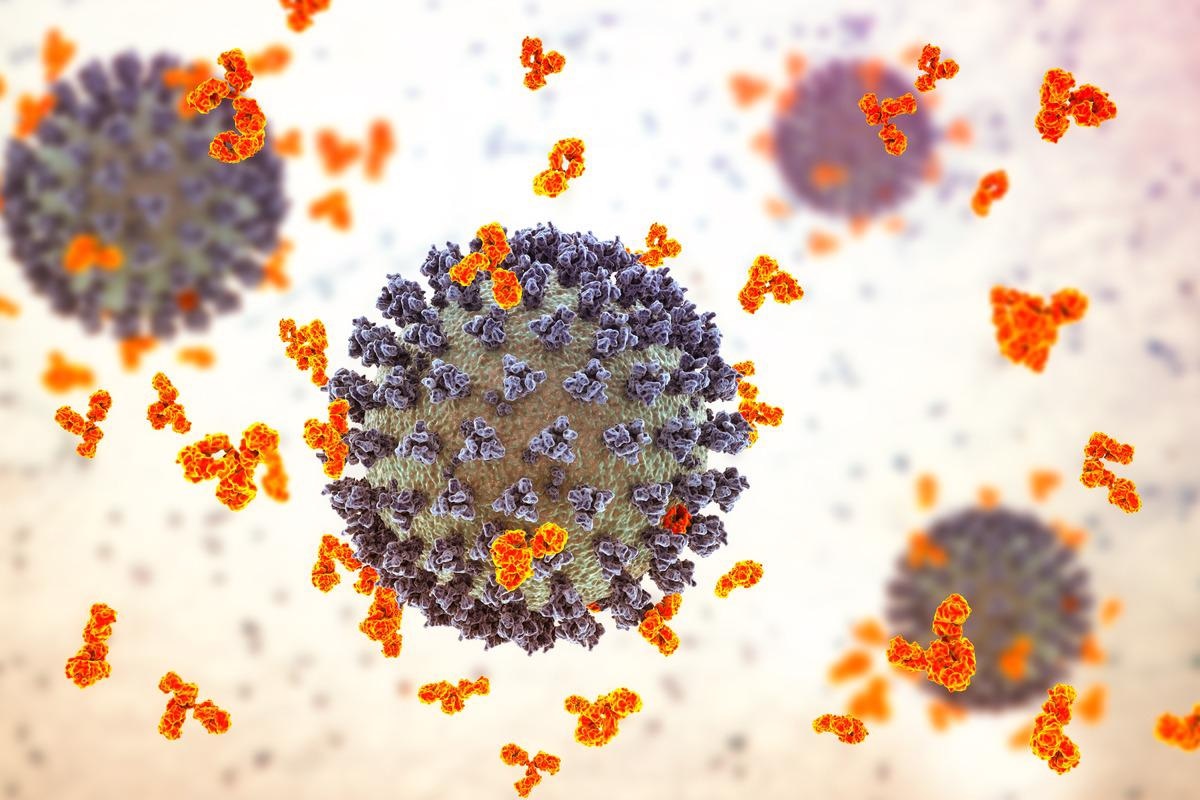A recent study published in The Lancet Microbe investigated the potency and functionality of T-cell and humoral responses against the severe acute respiratory syndrome coronavirus 2 (SARS-CoV-2) wild-type strain and its variants.
 Study: SARS-CoV-2-specific antibody and T-cell responses 1 year after infection in people recovered from COVID-19: a longitudinal cohort study. Image Credit: Kateryna Kon/Shutterstock
Study: SARS-CoV-2-specific antibody and T-cell responses 1 year after infection in people recovered from COVID-19: a longitudinal cohort study. Image Credit: Kateryna Kon/Shutterstock
Background
The memory immune response plays an important role in preventing coronavirus disease 2019 (COVID-19) infections and the severity of the disease. However, extensive research is needed to understand the robustness of the protection provided by this immunity against SARS-CoV-2 strains.
About the study
The present longitudinal cohort study characterized cellular and humoral responses specific to SARS-CoV-2 in COVID-19-recovered individuals who neither had reinfection nor received a COVID-19 vaccine 12 months post initial infection. The team also assessed the effect of SARS-Cov-2 variants on T-cell and B-cell responses in this cohort.
Individuals with a history of laboratory-confirmed COVID-19 who were treated at the Wuhan Research Center for Communicable Disease Diagnosis and Treatment from January 7th to May 29th, 2020, were included in the study. A follow-up visit was attended by the study participants between December 16th, 2020, and January 27th, 2021.
The team classified disease severity using a seven-category scale during the patient’s hospital stay. Patients hospitalized due to COVID-19 but did not require oxygen support belonged to the third category and were grouped as moderate; hospitalized patients requiring supplemental oxygen belonged to the fourth category and were considered severe. In contrast, critical patients belonging to the fifth and sixth categories were hospitalized and needed high-flow nasal cannula, extracorporeal membrane oxygenation, non-invasive mechanical ventilation, or invasive mechanical ventilation.
Venous blood was obtained from the participants and processed to isolate plasma and peripheral blood mononuclear cells (PBMCs), which were used for antibody and
T-cell response assays. The study also performed an enzyme-linked immunosorbent assay (ELISA) to evaluate the titers of immunoglobulin G (IgG), IgM, and IgA antibodies against the SARS-CoV-2 nucleocapsid (N) protein, spike (S) protein, and receptor-binding domain (RBD). Moreover, the team measured the titers of neutralizing antibodies induced against SARS-CoV-2 wild-type strains, Beta and Delta variants using a microneutralization assay.
Responses of the memory T-cells to overlapping peptides on the SARS-CoV-2 membrane (M), envelope protein–open reading frame (E/ORF), S, and N proteins were detected and assessed using intracellular cytokine staining (ICS) and enzyme-linked immune absorbent spot (ELISpot). Furthermore, antibody and interleukin-2 (IL-2), interferon γ (IFNγ), and tumor necrosis factor α (TNFα) were evaluated as per age and disease severity.
Results
The study results showed that eligible participants included 1096 individuals who had recovered from a primary SARS-CoV-2 infection 12 months before enrollment. Disease severity of the initial disease was moderate in approximately 26.4%, severe in 67% and critical in 6.7% of the participants. The average duration between symptom onset and the follow-up visit was 347 days, while the median age of the participants was 58 years, with 53.6% being males.
At the follow-up visit, 46.9% of participants reported a minimum of one symptom, mainly sleep difficulties, fatigue, and muscle weakness. Moreover, 1096 plasma samples were used to perform ELISA. Almost 85.8% and 81.6% of the 141 paired plasma samples had neutralizing antibodies at six- and 12-month-follow-up visits. No significant differences were found among the disease severity groups except the critical group, which showed a notable decrease in the neutralizing antibody titers between six and 12 months of initial infection.
Memory T-cell responses were observed in 90% of the recovered patients, indicating SARS-CoV-2-specific T-cell responses towards a minimum of one SARS-CoV-2 peptide pool. However, there were significant differences in the extent of SARS-CoV-2-specific T-cell responses among the groups. Also, the IFNγ T-cell responses toward the E/ORF peptide pool were lesser than those towards the N-peptide pools.
Seropositivity for N-IgG, S-IgG, and RBD-IgG was 82%, 95.2%, and 94.2%, respectively. Notably, the titer values for S-IgG antibodies were higher in patients with an initial severe infection as compared to moderate infection. Also, the anti-SARS-CoV-2 IgG titers increased with the increasing age of the participants.
Furthermore, the assessment of plasma obtained from COVID-19-recovered individuals 12 months post-infection showed that 82%, 48%, 23%, and 49% of the participants had neutralizing antibodies against the SARS-CoV-2 wild-type strain, and D614G, Beta, and Delta variants, respectively. This indicated that the neutralizing titers were remarkably higher in the wild-type plasma samples as compared to the aforementioned variants.
Conclusion
Overall, the study findings showed that anti-SARS-CoV-2 cellular and humoral immunity was present in most COVID-19-recovered patients who experienced moderate-to-severe initial infections. The researchers believe that the present study highlighted the significance of T-cell and B-cell immunity in the development of future SARS-CoV-2 vaccine strategies.